ARCHITECTURAL PROJECTS
HOMMAGES
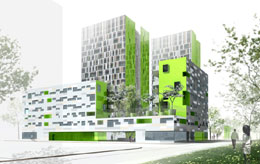
09 August, 2010
F and F Architectes
Through pragmatic methods of analysis on multiple levels focusing on issues we aim to identify the key parameters that are encompassed in the design and sets out the essence of the project in a close dialogue with the client.(interview & projects)
(Following interview & projects)
F+F Architectes were founded in 2006 by Aurélie Fechter and Johan Fritzell.
Johan Fritzell was born in Stockholm, Sweden at 10-03-1975. He studied Architecture at the Royal Institute of Technology at Stockholm, Sweden and continued his studies at the Architectural Association inLondon. He worked at the Atelier Frank Hammoutene in Paris (2000-1), at the Brenac Gonzales Architectes in Paris (2001-4) and as a freelance architect (2004-5). In 2006 he founded F+F Architectes with Aurélie Fechter.
Aurélie Fechter was born in Strasbourg, France at 12-07-1975. She studied Architecture at the Royal Institute of Technology at Stockholm, Sweden and continued studies at the EAS in Strasbourg.
She worked at the Fitzroy Robinson Ltd in London (1999-2000), at the SLH Sexer Loyrette Holding in Paris and at the Architecture Studio office in Paris. In 2006 he founded F+F Architectes with Johan Fritzell.
Working at scales ranging from furniture, interior-design to housing, public buildings and urban planning, our different backgrounds makes for the richness and complementarity in our approach of the architectural project.
Through pragmatic methods of analysis on multiple levels focusing on issues of density, flexibility, sustainability, social and cultural identity, economy, context, program, movement, flow, form and function, we aim to identify the key parameters that are encompassed in the design and sets out the essence of the project in a close dialogue with the client.
Conversation with 'f+f architectes'
The interview was realized by Alexios Vandoros, Architect - chief editor of the e-magazine GreekArchitects.gr
Alexios Vandoros :Can you describe the reasons that determined your decision for being an architect?
Johan Fritzell : This is something that has come very naturally to me, as if there was no other possible studies up for consideration. Always had an interest in conceiving built environments, the act of creating. All other dimensions implied within this profession and architecture in general, have come to my understanding only during my studies.
A.V.: How would you describe your 'morphosis'? Which is your thesis for the education of
Architecture in Europe nowadays?
J.F.: With every new project, we always try to have a multiple input approach, as opposed to a linear process, and encompass the widest sets of parameters. Of course we start of with the projects context (built, cultural, economic, programmatic, climatic,...), to which we add extra layers by the use of generative tools (through testing, modelling, drawing and diagramming specific conditions). From a site or programmatic analysis we try to extract a key feature, strong enough to drive the project. To us the most important is to create a logical context, or process, within which the project can unfold.
This brings us to the second part of your question. Through my education (Architectural Association London, Royal Institute of technology Stockholm), I have come to realise that the foundations for a successful* project lies in it's process; setting up a logical context makes for a better dialogue with the client versus coining an idea that is either likeable or not. It also removes or simplifies part of the sketching phases as most decisions derives from it. therefore I think that architectural education should be about offering insight in many generative processes, ways of conceiving architecture together with critical thinking, in order to form ones own way of working.
When it comes to questions of techniques, materials, tendering procedures, I believe these are best learnt on site, in an office. The French architectural education has now adopted a scheme similar to british RIBA part 3, where a year in a firm spent following through a project is compulsory to gain a full architect's licence.
*considered the design phases
A.V.: How easy or not is it for a young architect to practice architecture nowadays? How did
you start your own practice and when did you establish your own firm 'f+f architectes'?
J.F.: I think the biggest difficulty, especially in France, that young practices are facing is that of a « catch 22 »: to do, you have to have done. Most clients, especially in tendering for public buildings and housing that constitute the biggest marketshare for architecture in france, will only consider architects with solid references, meaning that have at least one built reference for the same type of program. The procedure in France for public buildings being based on restricted competitions ( between 3 and 6 firms short-listed for an initial competition phase), limits the possibilities for young practices. In our case, we still have to associate with more established firms to have the possibility to compete.
Thus, the challenge for young practices is to create new opportunities. For us, we try through open international competitions and various interior projects for private and institutional clients.
After having worked in different Parisian firms, and 2 years as freelance architects, establishing f+f architectes with Aurélie Fechter in 2006 came naturally as we had been commissioned an urban study on a 7ha lot in the center of Skopje, F.Y.R.O.M., for international developers. Prior to this, we had worked together on several open international competitions and and interior designs.
A.V.: Do you feel limited by any system or theory of references?
Between Urban language vs Contemporary city and Reality of contemporary city vs theoretical or
idealized city. The paradigm of the New Songdo City development.
J.F.: To us, the limitations of a system or theory of references lies principally in the expectations of the client, and or public assessors (local authorities, urban regulations, neighbours ....), as by de facto, referring to known models is reassuring. We've been confronted to this mainly in our project for Skopje, where the client asked for a thematic around Alexander the great and Alexandria. Instead we derived a proposal from the Macedonian Korzo, a traditional pedestrian street with stands or kiosks that are often located along the central axis. From there on, we could develop an entirely pedestrian mix-use scheme, with all car traffic and parking solved below ground, taking into account principles of sustainability and introducing new property concepts for FYROM, such a mixed public/private financed social housing. I think this starting point, that actually spoke more to the clients and local authorities than a hippodamian plan, allowed an evolution in the project towards something more idealised.
A.V.: How would hierarchise priorities or principles in your work?
J.F.: I think, in this profession, the notion of pleasure is extremely important. In order to output the necessary energy to carry through even the smallest project, for us it is primordial that we believe in the idea and the design. In the initial phases with the client, we usually propose two entirely different approaches to the project, as to involve the client early in the design phases. From there on it is easier to develop a scheme that keeps us going and that fits or even specifies the expectations of the client.
When it comes to the individual project, we try to hierarchise design parameters as late as possible in order to keep most elements in the project, but usually we have an inside out approach as function and interior spaces would be the main concerns early in the design. This focus gradually shifts to the relation to exterior, context, building skin.....
Real production vs experimental design or research.
Responds to the given context (in the terms of context is meant physical, temporal and cultural)
vs to create a new context.
A.V.: Where would you situate your architecture and how do you relate to these two poles?
J.F.: For us the notion of research is central to our work, but it is always carried out with real production in mind. We have no interest in utopies, unless they are feasible. All of our building designs are derived from context, usually in response to context related issues; this, however, doesn't prevent a shift from operating as they generate their new context.
A.V.: Would you characterize your architecture as identifiable? Do you believe that
architecture should be identifiable?
J.F.: If by identifiable, you mean contributing to a cohesive identity of our global production, it is probably and inevitably an ongoing process. But as we try to avoid all preconceptions prior to any project, using various angles of approach with no preconceived output, I don't believe it is an aim or will from our behalf. On the same level, the use of formal or stylistics elements as gimmicks to create an identity, as a sort of architectural branding, is something we believe to often be a dead end, an architecture of the now that rapidly opens itself to critique, and is something we avoid giving in to.
On the other hand if by identifiable you refer to any remoteness between an architecture and its built context, it is an issue we have a more schizophrenic attitude towards. Clearly the building as a solitary, sitting totally isolated from it's context, often creates more issues than it tries to solve . But when you try to propose alternatives, inevitably you differ from the context. Or way to go about it, is to start from context, always keep in mind how we reconnect to it, no matter the output of our project.
A.V.: Which is your opinion about the dominantly self-referential or narcissistic architecture
that leads the worldwide architecture production today?
J.F.: First of all there is the question of starchitecture (Nouvel, Zaha, Gehry and the likes..). For example, in France, for every more ambitious project, the same names recur in the selection for shortlisted competitions, no matter the quality or pertinence of their proposals in previous competitions/projects. For clients, it is probably the reassurement of buying into a specific brand. Consequence of this, is a dichotomy between this architecture and the architecture of the everyday, together with a slow renewal and a total lack of versatility of the architectural production.
Secondly it also has to do with the time we live in. Visualisation and 3D software, has , through the image, or architectural render, completely transformed the way of communicating architecture. There is also what I would call an "internet disease", where the luxury of overabundance of information has induced into a fed-up state of extremely short attention span, where everything has to go fast, so fast.
Consequence of this is that architecture is reduced into, consumed and assessed through a collection of snapshots that is clicked through rapidly. This leaves very little room for the unspectacular and the unidentifiable, let alone any critical thinking beyond the representations.
A.V.: Do you believe that exists a bridge between intellectual discourse of architecture
urbanism and the intelligibility of the public in general?
J.F.: Clearly there is a gap. This is only normal today, where any specialist discourse is hermetic to the general public. But also, very few persons outside of the profession are interested in architecture and urbanism beyond aesthetic considerations. However elements of this discourse are brought out to the public either through built projects or exhibitions, and many people are genuinely interested in novelty when explained and discussed with.
A.V.: Have you ever been in Greece? If yes, which is your opinion about the built
environment? How would you describe Greek Architecture nowadays?
J.F.: I've been to Greece, but for me this was so long ago, that, fairly, I couldn't sincerly comment on Greek architecture.
A.V.: I inform you that the Greek Building Regulation prohibits the construction of tall
buildings in the Greek cities (allowing a maximum height of 27m). Do you think that
skyscrapers are a solution for the expanding cities of the 21st century and particularly
for the Greek cities? How would you suggest using these kinds of structures in the
contemporary (mega)cities of 21st century?
J.F.: With increasing populations, property values, contemporary (mega)cities are left with little choices in terms of expansion. Concentrating functions in one point through vertical stacking would solve many of the main issues that these cities are facing, such as transportation, pollution, while freeing up land for green areas or any public facilities needed, and making these accessible.
Problem, at least in Europe, is that experiments in high-rise have mostly occurred in specific areas, with very little programmatic diversity, such as la Défense near Paris, that is first of all an office area, with commercial activities and a small minority of housing blocks.
I think the way to go about it, is to gradually let loose building regulations, as to have a progressive evolution towards high-rise construction , while still preserving areas of historic value, in the way that New York has developed, with it's skyline that has constantly evolved during 20th century. But it is absolutely necessary that this is carried out with sustainability and ecologically thinking in mind, rather than pure capitalist interest. Maybe then we will have an urbanism of the future.
Following projects >>
Pixelblock
Proposal for the refurbishment of 2 housing blocks and construction of 38 flats and commercial activities
Collaboration with Atelier Du Pont , Paris
client: OPHLM Bobigny, France
area: 3400 sqm new construction
cost: 1350 €/ sqm (total 4 580 000 € excl. VAT and underground parkingspaces)
design 2007
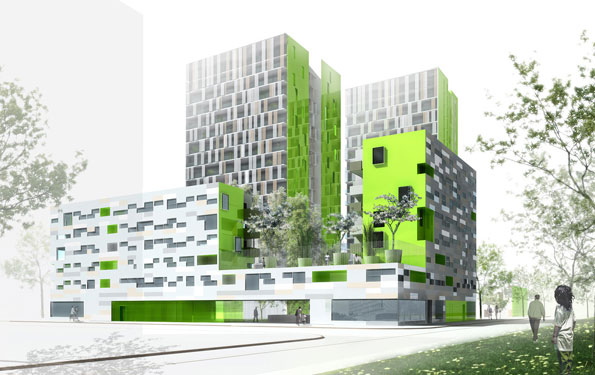
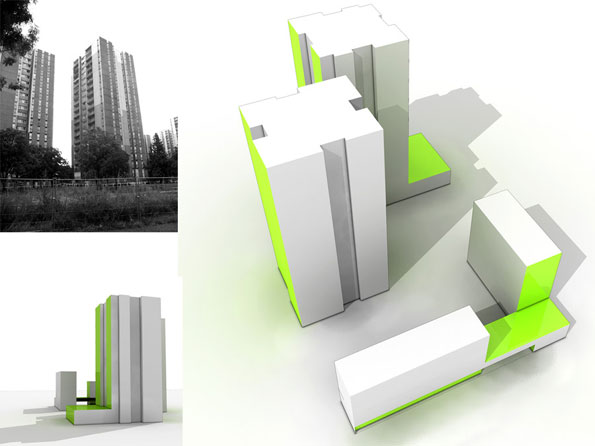
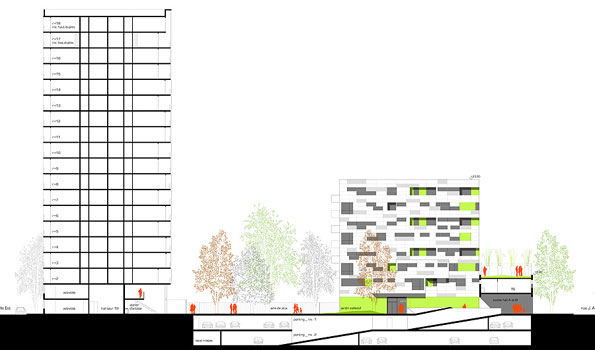
This project is part of the refurbishment of the Karl Marx city-block in Bobigny, a run-down suburb to Paris. The new building of 38 flats and extensions ( commercial activities) are placed strategically as to fill the corner of the site, and shift towards a city-like urbanism with closed blocks. The new building is aligned on a pedestrian street, and sets up a principle of "residencialisation" in its relation to the existing buildings, with public, collective and private gardens, a plaza and playgrounds.
As building regulations no longer permit constructions at the same height as the existing towers, the new building is split on the corner as to mimic the profile of the towers and give views on the existing buildings. To further blur scales, unify the constructions and maintain a urban unitary identity, the façades of the new building are pixelated by using coloured metallic plates of shifting reflections and windows at different heights and sizes. the existing tower-block are rendered more smooth with new exterior spaces and balconies, duplex apartments at the topfloor and activities and artist spaces on the groundfloor and the first floor.
All the flats in the new building have their living-rooms in the built corner as to offer views in multiple directions.
Urban Mask.
An apartment block in Lima where a vertical unifying wooden structure act as blind and protective device for the fully glazed skin and the apartments behind.
client: Arquia SA , Lima , Peru
area: 4 700 sqm
cost: total 7 050 000 € excl. VAT
design 2007
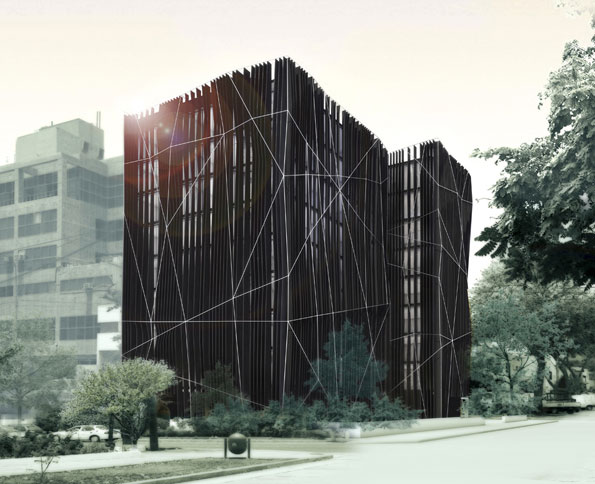
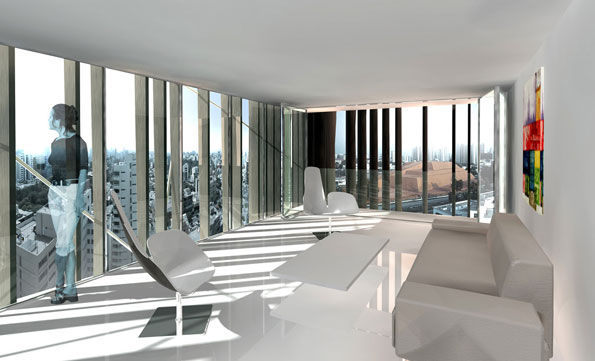
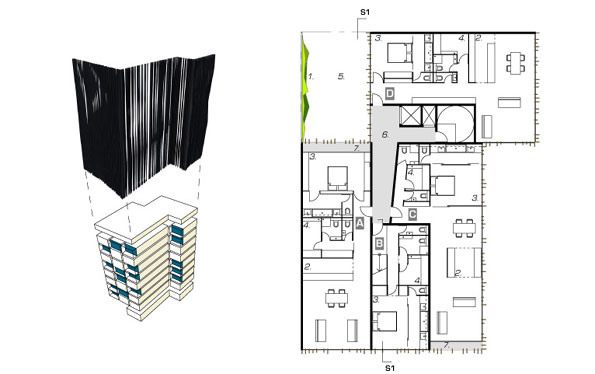
This operation of 28 loft-style apartments is Located in the San Isidro district, Lima, near Huaca Huallamarca , an old Inca shrine.
In order to bridge the dichotomy of modern living, i.e. maximum transparency while preserving privacy, the largely glazed façade is covered with unevenly spaced vertical wooden beams: they work as structure, sun-shades, sound-dampers and protects from lateral views, while preserving full views on the outside.
The changing profiles of these beams, gives the building a perceived massiveness, ever shifting with the angle of view, and it's singular identity; enhanced by diagonal structural rods, it contrasts with the transparency and openness of the flats: transparency with preserved intimacy.
To give every flat a view on the shrine,the flats are devised as tubes split into a living and sleeping side, with all the living rooms facing the shrine. To ensure views, light and most of all make up for the tightness of the site, one flat is pushed back and wrapped around the staircase, another is folded into a duplex apartment with both living room and bedroom facing the shrine.
A vertical garden located on the inner court acts as a green lung for the building and works as a scenery for the bedrooms of flat type A and D, and the entrance.
Boxed living
transformation of an office building into 4 apartments and retail space
client: private
area: 750 sqm
cost: total 1 100 000 € excl. VAT
design 2007
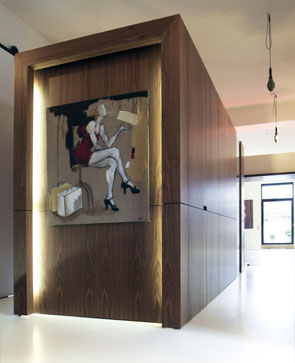
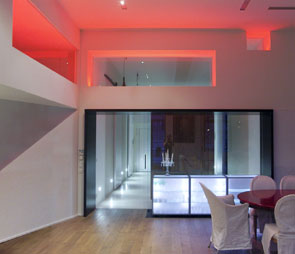
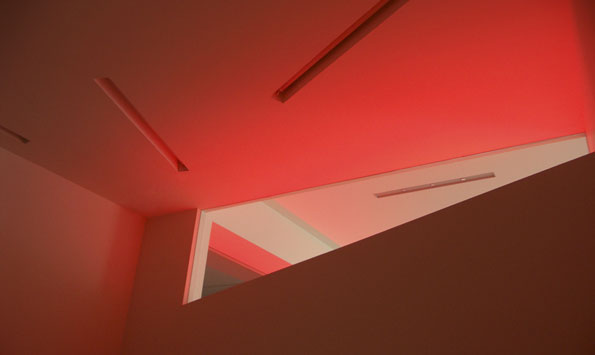
For this reconversion of an old office building into apartments, the depth of the floor slab (12x25m), lend us to a solution where all necessary technical utilities are located centrally within the floor plan,the rooms organised around.
These spaces are materialised by a box, clad in american walnut veneer, that sits in a central hall and gangway, around which are located bedrooms and bath. The central hall opens up on the living rooms through a large glazed frame, that brings natural light into the heart of the apartments. The volumes and geometries are put forward through the use of materials (wood, metal, concrete) in a restricted colour palette. These neutral tones, that are modifiable through the use of coloured light, renders a higher flexibility in the furnishing of the different rooms.
Extension and restructuration of an existing Sport-facility
A large roof unifies and structure the different programmatic elements while ensuring all climate control of this sports facility.
Collaboration with KOZ architectes
client: city of La Baule Escoublac
area: 5200 sqm
cost: 1250 €/ sqm (total 6 500 000 € excl. VAT)
design 2007
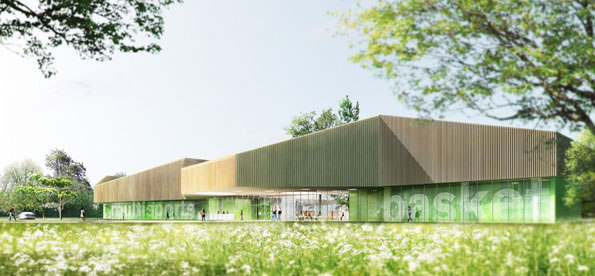
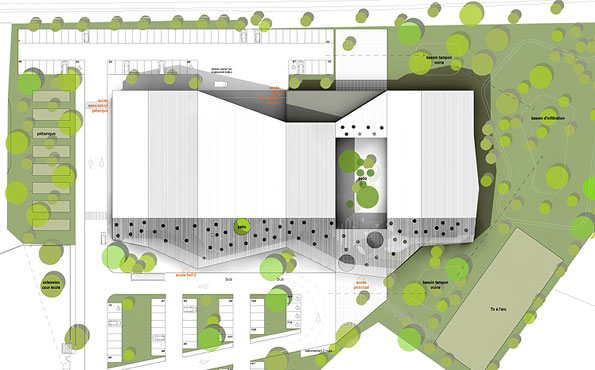
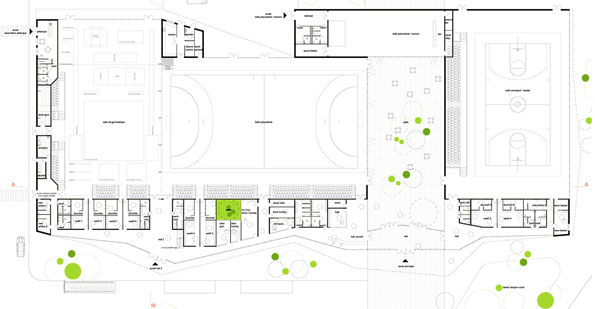
For the extension and renovation of this sports facility in la Baule on the French west coast, we started off from the existing pitched roof and structure of the gymnastic hall that is kept. An extended, wooden clad roof, unifies the different elements of the program (basket, gymnastic, eventspace, theater, archery) while taking up the existing structure.
A long glazed passageway with changing width gives access to the main halls and changing rooms, while being a space for temporary events. The climate control of this passageway is handled through the large overhangs of the roof, that cast shadows during the summertime, while still enabling sunlight to heat the gallery during the winter.
Circular lightshafts brings natural light in all spaces, while ensuring a natural ventilation of these spaces.
Origami
By using an analogy to origami, the Japanese art of paper folding, a surface is folded to become floor, ceiling, wall , furniture and structure the space in this showroom
client: TF1 SA, France
area: 200 sqm
cost: 1400 € / m2 (280 000 € excl. VAT)
design 2006
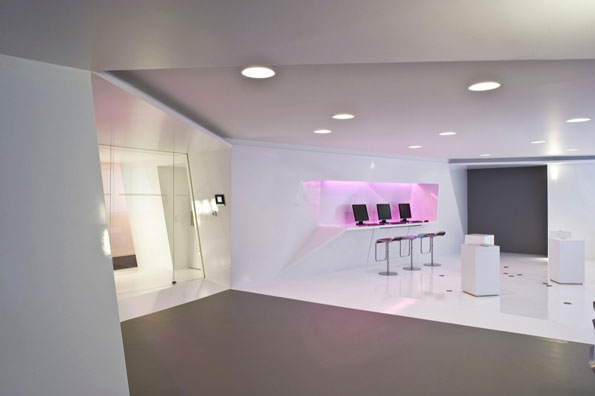
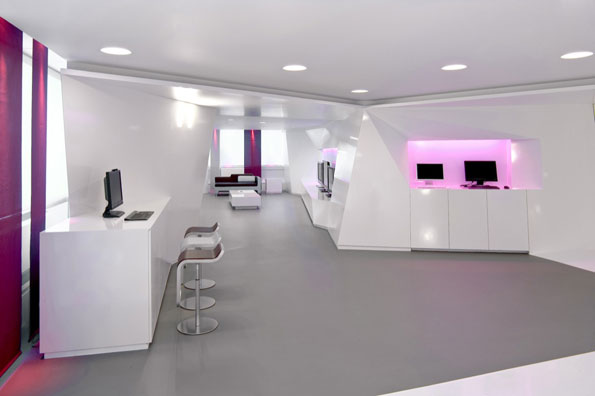
This showroom for one of the main tv-channels in France is used to inform staff and clients about new broadcasting and information technologies that also works as an occasional setting for interviews and short documentaries.
The type of objects on display and presented ranges from TV on-demand, cellphones and ipods to video-game consoles and digital worlds.
Located in their office tower in Boulogne, near Paris, the idea was to develop a spatial concept that clearly differentiates itself from the structure and spatial layout of the existing tower. As an analogy to origami, the Japanese art of paper folding, a surface, upon which all the necessary elements and information are mapped, is folded. Taking into account visual axis and programmatic connections, this folded surface becomes floor, ceiling, wall , furniture, projection screen as it defines spaces (showroom, test lab and server room), defines areas and "stations" for presenting the various themes and groups of equipment and technologies.
This enabling structure contains storage spaces and all the necessary technical elements and connections.
It is made of white lacquered MDF boards mounted on steel space frames. All elements are made through computer controlled cutting and milling. The use of various coloured lights changes the mood of the space accordingly.
F+F architectes
- E-mail : contact@fplusf.fr http://www.fplusf.fr
projects
2008
TRADE_interior Trade Council of the Swedish Embassy, Paris 200 sqm under construction
Studio_interior studio-flat appartment, furniture, Paris 30 sqm unde¬r construction
ABTB_interior appartment, Paris 212 sqm completed
GRG_housing 25 row houses , Garges France 3000 sqm with atelier phileas
Play_education primary school, Rouen France 4500 sqm vvwith atelier phileas
2007
Urban mask_housing 28 loft style appartments, Lima Peru 4700 sqm
Pixelblock_housing 38 appartments+refurbishing of existing blocks, Bobigny France 3400 sqm with ADP Architectes
Climate roof_sports extension of the sports facility of la Baule France 5200 sqm with KOZ Architectes
Suspended pod_health extension of A. Paré hospital, Boulogne France 2175 sqm with BP architectes
MUX_housing construction of 40 appartments , Meaux France 3500 sqm with ADP Architectes
hollow tektite_interior conference room for the editorial board, TF1 TV, Boulogne France 250 sqm under study
info_interior tv-guests waiting area and lounge, TF1 TV, Boulogne France 90 sqm completed
Europan 9_urbanism Sion, Switzerland 24 hA preselected project
2006
Origami_interior showroow for TV channel TF1, Boulogne France 200 sqm completed
Floating Box_housing tranformation of an old grainstorage into guesthouse 180 sqm under construction
Asplund_culture competition for the extension of Stockholm City Library, Sweden 23 000 sqm
Alex_urbanism proposal for urban mix use development, Skopje FYROM 7 hA
boxed living_housing transformation of an office building into 4 flats and retail space 750 sqm completed
kulturhuset kanten_culture geomuseum, cinema and café at Fakse quarry , Danemark 4200 sqm
Deno_ interior appartment ,Levallois, France 180 sqm completed
projects by a. fechter and j. fritzell prior to 2006
2005 Boler_culture competition for Boler Church, Oslo Norway 4000 sqm
2004 Appartment F_appartment , furniture, Strasbourg 265 sqm completed
2004 Appartment L_interior transformation of a garage into a loft, Paris 212 sqm completed design
2003 Slice House_housing competition and exhibition for small mobile architecture
**Contemporary Architecture Work - Presentation of Architecture Projects - Greekarchitects.net as the English version of Greekarchitects.gr represents the work of Architects worldwide in its pages. (Invitation for participation)










